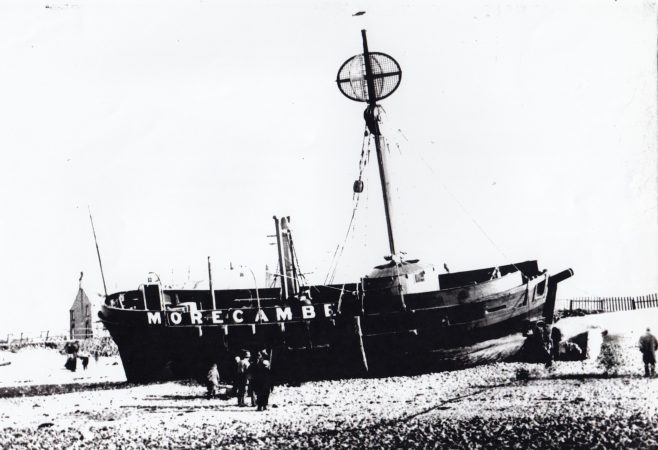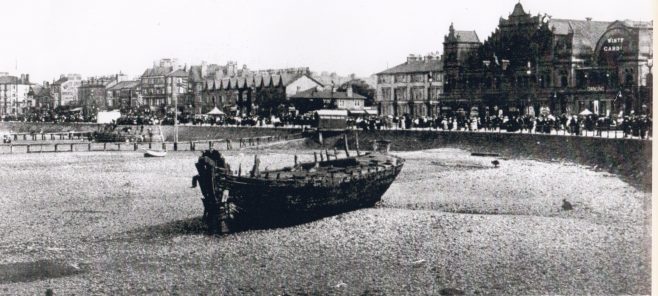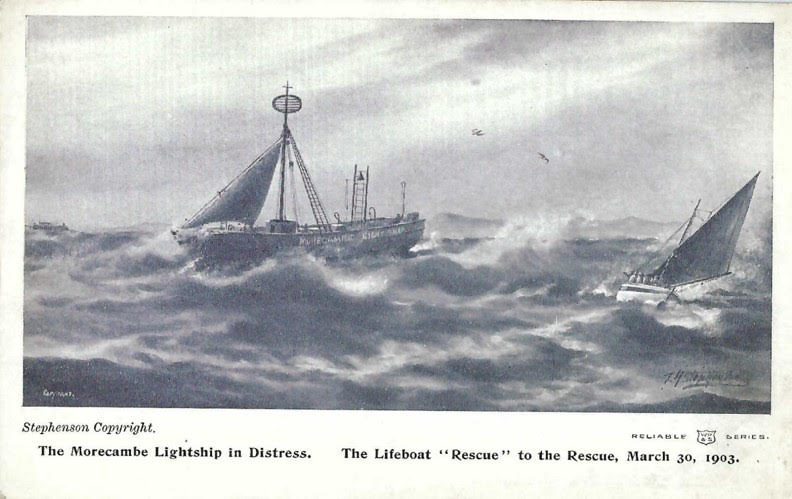Wooden schooner Fylde
built Hugh Singleton, Fleetwood 1857
From 1863 in position as Morecambe Lightship (marking channel into Morecambe)
Driven from moorings in 1894 onto shore near Battery Inn/Hotel
- abandoned.
From Liverpool Echo - Monday 12 February 1894
MORECAMBE LIGHTSHIP DRIVEN ASHORE. Yesterday a strong
northerly gale and heavy sea prevailed at Morecambe, During the
evening the wind increased until before midnight it blew perfect a
hurricane. About that time [11 February 1894] the lightship,
maintained by the Midland Railway Company at the entrance to Morecambe
Channel, nearly six miles from the harbour, broke from her moorings on
the edge of the bank known as Clark's Wharf, and bumping over the
bank, drifted before the storm in the direction of Heysham. The
position of the men in charge, George Alexander, Morecambe; Abbott
Taylor, Morecambe; and Joseph Crossdale, Ulverston, was most perilous,
the heavy waves washing completely over the vessel, which was entirely
at the mercy of the wind and sea. They took refuge first in the
lamphouse, and then in the cabin. Meanwhile, the vessel drove towards
Heysham Point. Had she struck there not a soul could have been saved.
Fortunately she just cleared these dangerous rocks, and the crew,
hoisting the foresail, headed for the shore, and about four o'clock
the vessel was driven broadside on high up the beach opposite
Sandylands, close to the Battery Inn, Morecambe [now Battery Hotel, SW
of the Stone Pier]. On the tide receding, the crew reached shore,
extremely thankful for their providential escape. During her four
hours' buffeting in the darkness of the night, the vessel's bottom was
damaged, bulwarks stove in, and other damage sustained, but there is
little probability of her being got off. The tide washed heavily over
the promenades and harbour, and considerable damage done by the
hurricane to new buildings.
Lightship ashore near Battery Inn also called Sandylands.

The wreck of the lightship was left on the shore - and was still
identifiable around 1920 (from Keith Willacy collection; Alhambra in background):

From Leeds Mercury - Thursday 01 November 1894
THE NEW MORECAMBE LIGHTSHIP. - There arrived at Morecambe
harbour on Tuesday morning, a vessel, purchased by the Midland Railway
Company, to replace the old Morecambe lightship which, during a severe
storm in February, broke from her moorings, and after drifting a
distance of nearly ten miles was cast ashore near the Battery Inn,
Morecambe, after having for between thirty and forty years guided the
mariner to the entrance of the Morecambe channel, at the mouth of the
bay. The old hulk was subsequently floated, but on survey was found to
be too seriously damaged for future service, and a trading vessel was
temporarily engaged by the company. Since then they have purchased the
schooner Queen of the South, engaged in the fruit carrying trade in
the west of England. This is a much larger vessel than the old
lightship, being 82ft. long, 18.5 ft. beam, and 12ft. deep, with a
gross tonnage of 187, and strongly built of oak and elm throughout.
She has been re-fitted for her new service by Mr. Paul Rogers,
Carrickfergus, having received an additional sheathing, and been
otherwise strengthened in various ways, and a lamp-house erected on
deck. After the remainder of her fittings have been put in at
Morecambe, she will be placed at her station.
Lancaster Guardian - Saturday 29 December 1894
The Morecambe Bay lightship broke from her moorings, and was
taken to Fleetwood Harbour by the steamer Ariadne. It may here be
stated that the Morecambe new Lightship weathered the storm admirably.
